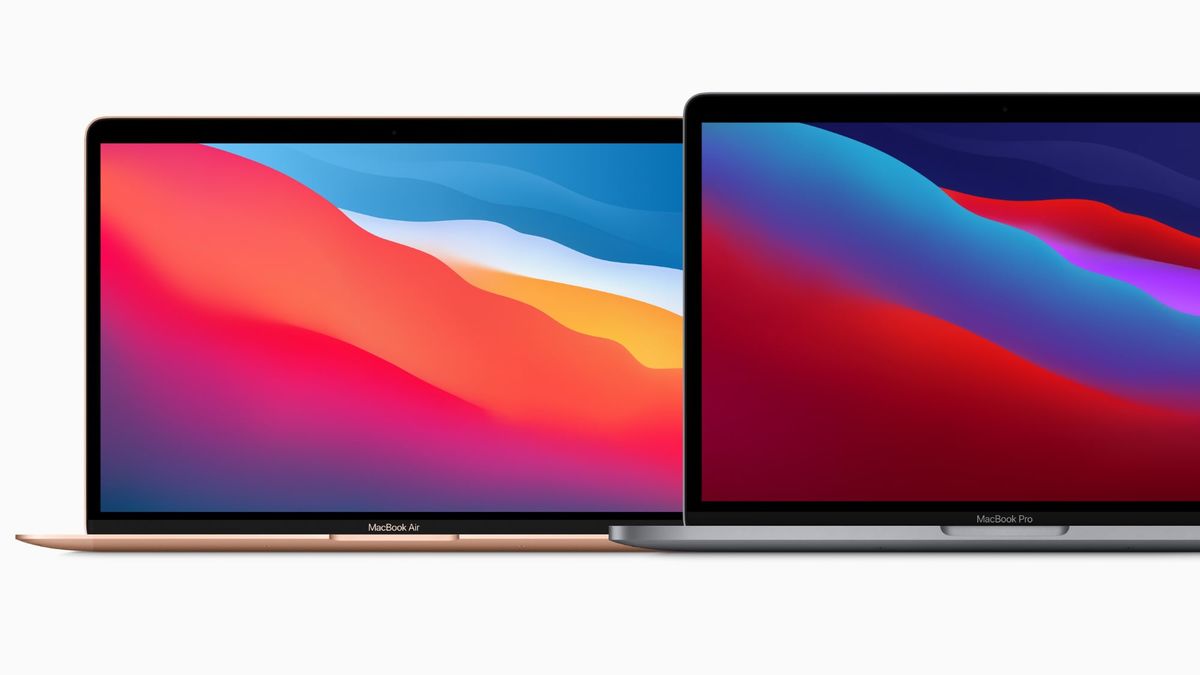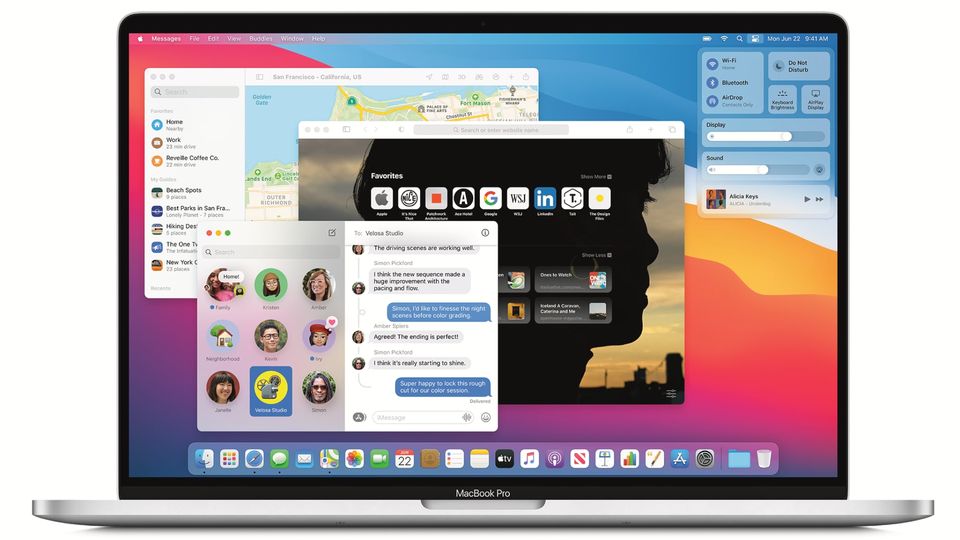First look: Apple's new M1 laptops break cover
New MacBook Air and MacBook Pro laptops are the launchpad for Apple's own M1 chip which kicks Intel to the curb.

Apple's latest MacBook Air and MacBook Pro laptops look almost exactly the same as the models they replace, but there's a world of difference under their polished aluminium shells, with the long-standing Intel chips ousted by an all-new M1 processor created by Apple.
It's the start of a two-year transition away from Intel which will eventually see all Apple laptops and desktops running on a family of M-series chips.
Those chips, in turn, have been developed from the A-series ARM processors which power the iPhone and iPad, although the first generation M1 is far more muscular.
It packs eight processing cores: four are designed for high-performance tasks, with four more built around energy efficiency.
The M1 intelligently switches between these cores, or runs them all at once, depending on what's needed.
Simple apps and modest usage – such as Web browsing, email, office-style apps and music or video playback – will rely on just the the energy-efficient cores for maximum battery. Invoking a heavy-duty app or a task within that app will spin up the performance cores.
The M1 also contains an eight-core graphics processing engine, although the entry-level MacBook Air uses an M1 chip with only seven graphics cores.
A raft of other components, many of which are usually contained in their own chips on Intel-based laptops, are built into the M1 to create a more power-efficient 'system on a chip', such as the security system (previously the domain of Apple's own T2 chip).
The upshot of all this, Apple says, is a potent mix of increased performance and longer battery life, especially running software designed for the M1 architecture, as well as the tighter integration between hardware and software unlocking new features and capabilities.
Apple's M1 MacBook Air
The M1 MacBook Air retains the familiar wedge shape, two USB-C ports and 13-inch screen of its predecessor, although it ditches the fan needed to cool the Intel chips, resulting in a totally silent system which Apple says is good for up to 15 hours of wireless Web and up to 18 hours of video playback.
Apple is however touting the M1 Air is a far more capable system than in its Intel days, moving from a lightweight all-rounder to a mid-range machine able to run creative apps which would see previous models choke.
Pricing remains the same, starting at $1,599 with 8GB or RAM and a 256GB solid state drive; it's on sale from November 17.
Disappointingly in this age of remote working and Zoom, the MacBook Air still relies on the same sub-par 720p video camera of previous models, although Apple claims the M1's integrated image processor will make for better FaceTime chats.
Apple's M1 MacBook Pro 13
The M1 MacBook Pro 13 is actually Apple's spec'd up model with the TouchBar, which will keep the same $1,999 starting price when it goes on sale on November 17.
Under the hood there's the same M1 powerplant as the MacBook Air. This opens an interesting aspect for at least this first generation of Macs built using Apple's own silicon: with only one processor in the family, there's no choosing between different chips such as Intel's Core i3, i5 or i7 as you move up through the laptop range.
That's likely to change in 2021 as Apple upgrades its higher-end laptops and desktops, potentially with a more advanced M1x processor.
Again, pretty much everything else from the current MacBook Pro 13 makes its way onto the M1 model – including the LED TouchBar, top-firing speakers and better microphones – and unlike the Air, the Pro includes a fan to help with cooling during extended heavy-duty tasks.
Battery life is rated at a promising 17 hours of wireless Web browsing and 20 hours of video playback.
MacOS 11
Meanwhile, this week will see the release of MacOS 11, aka 'Big Sur, which has been redesigned to look and work more like its iPhone and iPad counterparts including translucency, notification bubbles and widgets.

The Messages and Maps apps will gain many of the features available in their mobile counterparts, and the Safari web browser will get a translation tool, changes to tabbed browsing and a customisable home page.
Standardising on the ARM platform will make it easier for iPhone and iPad software developers to modify those apps to run on the Mac, or even let Macs run those apps directly. Cornerstone companies such as Adobe and Microsoft also plan to release ARM editions of their most popular programs.
The new M1 Macs will be able to run apps written for Intel chips through built-in Rosetta 2 'translation' software, albeit at slower speeds compared to native ARM apps as those begin to arrive in the coming weeks and months.
From 'Intel inside' to Intel on the outer
Intel has supplied its Core processors to Apple since 2006, when the company moved from the PowerPC platform, but Apple has become concerned with the relatively slow advance of Intel's architecture while continuing continuing to forge ahead on its tailor-made A-series processors.
In tandem, though, Apple was working on more energy-efficient chips for mobile devices based on ARM designs and continues to use those to power the iPhone and iPad.
In recent years, the speed and power efficiency of Apple’s mobile chips have rapidly increased, while the pace of improvement to Intel’s parts has slowed. This irked Apple executives, who pushed the company’s silicon unit to develop more powerful processors fit for the Mac.
Apple's current A and M series chips are built using 5nm technology, while Intel remains locked onto a larger-scale 10nm chip design that's less efficient for both performance and energy consumption. Intel doesn't expect to reach 7nm until late 2022 or early 2023, giving Apple a multi-year lead on its own designs.
Apple engineers are currently developing a new ARM-powered Mac Pro, said to be similar to the current design but about half the size, due to the increased power efficiency of the ARM processors requiring less cooling.
Additional reporting by Bloomberg



05 May 2016
Total posts 616
For running Windows on Mac, the switch to ARM is a disappointing one. I might get some of the last new Macs with Intel CPUs whilst they are still available.
Qantas - Qantas Frequent Flyer
11 Oct 2014
Total posts 691
Several of the better US-based tech mags ie: Techcrunch, Benzinga etc are freely mentioning cautions with this Apple ditching of Intel architecture to the custom Apple chip design.
It is virtually inevitable that some incompatibilities will arise over the next 12-24 months between various editions of Apple hardware and also between the new (ARM-based) architecture as well as software products (both Apple and 3rd party).
This, of course is no different from when Microsoft introduced the ARM-based Surface products. It took MS a few years to iron out the incompatibilities .. and they're a software company. It pays to be aware of some of these issues.
Hi Guest, join in the discussion on First look: Apple's new M1 laptops break cover